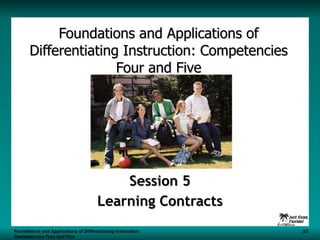
Session 5
- 1. Foundations and Applications of Differentiating Instruction: Competencies Four and Five Session 5 Learning Contracts Foundations and Applications of Differentiating Instruction: S3 Competencies Four and Five
- 2. The Simple Truths of Appreciation Foundations and Applications of Differentiating Instruction: Competencies Four and Five S3 -
- 3. The Human Brain Foundations and Applications of Differentiating Instruction: Competencies Four and Five S3 -
Notas del editor
- We don’t have all the answers, but we must believe that we are trying our best to prepare our students for the future and that is of us is making a difference in the lives of our students.
- This session provides an overview of learning contracts and the rationale that supports their use. Participants will: Explore how learning contracts can be used for the purpose of differentiating instruction for academically diverse learners. Explore the nature of a differentiated classroom and the thinking of the teacher in a classroom about her learners, their needs, and the plans she makes to address those needs. Have time to develop plans for using a learning contract in their own classrooms.
- Our work as teachers always reflects certain assumptions about teaching and learning – whether those assumptions are spoken or unspoken. Handout 1 presents some of the assumptions behind the video they will see.
- Activity 1 – Reading Topic: What are learning contracts? Bring a stopwatch and time the one minute chat. Mind Streaming also works effectively as a post reading/listening strategy in which students do one minute paired retellings of what they have learned from a reading assignment, video or lecture. Do a sweep and ask for points of interest. The comments can be put on chart paper by co presenter if time permits. Have participants read article.
- Activity 2 – Handout 4 Ask participants to read the case studies and answer the accompanying questions. Have participants work on this assignment alone because it relates specifically to their teaching setting. Ask for five volunteers to represent William, Melinda, Javier, Tracy, and Devon. Ask participants to assume that the continuum stretches across the room from left (very low satisfaction and success) to right (very high satisfaction and success). One at a time, ask the five volunteers to come to the front of the room and hold the name tags that identifies which case study he will represent. Ask for a group member to tell the case study representative where to stand on the continuum (for example, about one-third of the way toward the center of the room from the left) based on where she thinks the student would place himself and to give a reason for the placement. If others in the audience would place the student differently (and that should be the case), ask for each “new placement” and reasoning, and ask the case study representative to move accordingly. Ask the case study representative to place the card on the board at the point where most participants seem to agree the student would place himself in terms of school satisfaction and success. Activity 3 – Handout 5 Ask participants to work in groups to complete the exercise on the handout (15 minutes)
- On the video, learning contracts are used as one approach to address the varying learner needs of students like William, Melinda, Javier, Tracy, and Devon. Ask participants to suggest indicators to look for in the video to determine whether the use of contracts is likely to benefit a range of learners in the classroom. May include indicators from Handout 5. Example: participants might be concerned about whether students can work independently. List indicators on chart paper as participants offer them. 7 th Grade Language Arts classroom Strategy is useful across grades and subjects
- Activity 6 - Discussion.
- Activity 7 – Handout 6 Remind participants that it’s important to think about the students in the classroom, their needs, and the teacher’s plans to meet those needs as well as the strategy of learning contracts. The teacher’s awareness of student needs and desire to meet those needs is more important than any particular instructional strategy. Left column: A few descriptors of effectively differentiated classrooms. Right column: A few descriptors of effective curriculum and instruction. Work in groups to: (10 minutes) Add descriptors they feel are important to both lists Put a plus sign beside descriptors in both columns they feel were demonstrated on the video Put a minus sign beside descriptors in both columns they feel were lacking and should have been evident in this lesson Reconvene the whole group. Mark pluses and minuses on board as participants share their ideas. Ask participants’ reasoning. Discuss any additions the group made to the list.
